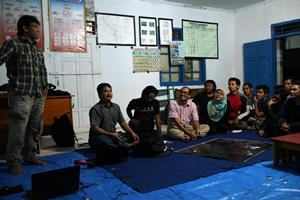Sena Adi Subrata
Provide population data of Palm Civet along with quantity of Civet coffee that can be harvested. And encourage people to manage their forest better for improving their livelihood.

Village meeting.
Learning from many experiences, apparently the biodiversity conservation actions that benefits local people will be long lasting. The people would like to have direct financial benefits as a reward of not overexploiting their biodiversity resources. Likely, the people favours financial over other benefits. This is also applied in Petungkriono forest, Indonesia.
Petungkriono forest is a part of Mt.Dieng. The mountain is rich in biodiversity. Despite its richness, only a few part of it was dedicated as conservation areas. In many other parts, particularly private lands near forest, people intensively cultivate land threatening biodiversity. In such area, biodiversity can be more effectively conserved by empowering people rather than encourage government to establish conservation area. However, the people will do it once they convinced that conservation action in their land is more profitable than usual land management.
Civet coffee production is potentially implemented as a strategy to save biodiversity in Petungkriono forest. The Civet inhabits the forest and forages in coffee plantation nearby. They eat coffee cherry and leave feces with beans there. As long as the forest and plantation undamaged, the Civet continuously produce bean, hence income for people. Therefore, conserving the plantation and forest, include all biodiversity harbouring in it, means securing income for people. The people have known it, but they need more reliable information to take actions.
The emerging challenge is to convince people using information about the profit received from sustainable coffee production. The sustainability need to be emphasized here, so the production should not harm the Civet’s population, its habitat and the forest. It will require data on Civets population and feces production, a matter that difficult to obtain by people itself. Helping people to obtaining the information, this work will be divided into three subsequent steps. The first step will be a pilot study to select appropriate technique for identifying species and individual of Civet. The second step will be estimating Civets population size and productivity. And the last step will be spreading the result out to local people to convince them saving biodiversity by Civet coffee production.
A key outcome of this work is improved motivation of local people to conserve biodiversity by producing Civet coffee. As long as the people receive high profit from managing Civet coffee, they will care their land and forest independently. A long lasting biodiversity conservation around Petungkriono forest can be expected.